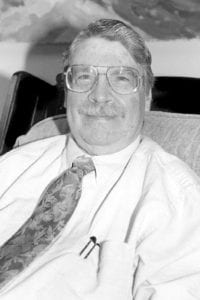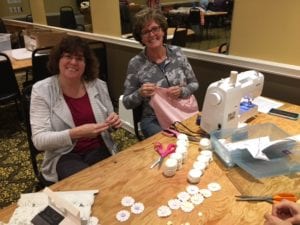By Daniel Dunaief
Humans learned to fly by studying birds and have learned to edit genes by understanding the molecular battle between bacteria and viruses. Now, we may also learn to take carbon dioxide, a necessary ingredient in photosynthesis, and use it to produce energy.
Eli Stavitski, a physicist at Brookhaven National Laboratory, is working with a new form of electrocatalyst to convert carbon dioxide into carbon monoxide, which can become part of an energy process.
Researchers have used noble metal electrocatalysts, such as gold and platinum, to promote this reaction. The problem with this method, however, is that these metals are rare and expensive.
In most of the reactions with other potential electrocatalysts, however, a competing reaction, called water splitting, reduces the amount of carbon monoxide produced.
Single atoms of nickel, however, woven into a lattice of graphene, which is a monolayer of carbon, produces a much higher amount of carbon monoxide, while minimizing the unwanted water splitting side reaction.
Indeed, these single atoms of nickel converted carbon dioxide to carbon monoxide with a maximum selectivity of 97 percent.
“The critical aspect of the work is that they show a change in chemical selectivity” resulting in the production of the desired products, Dario Stacchiola, a group leader in interface science and catalysis at the Center for Functional Nanomaterials at BNL, explained in an email. An important part of this study is the “ability to detect single atoms (atomic needles in a carbon-based graphene haystack) which is possible in [Stavitski’s] instrument.”
Stacchiola and Stavitski are collaborating on projects related to heterogeneous catalysis. They synthesize and test materials and then measure them in a state-of-the-art beamline. Carbon monoxide can be used to produce useful chemicals such as hydrogen, which can power fuel cell vehicles. The process can contribute to something called carbon sequestration, in which carbon dioxide is removed from the atmosphere.
While carbon monoxide is a deadly gas when it’s breathed in, Stavitski said manufacturing facilities deal with toxic substances regularly and have policies and procedures in place to minimize, monitor and contain any potential dangers. On the scale of toxicity, carbon monoxide isn’t the worst thing by far, he explained.
Indeed, in refining crude oil to fuels and chemicals, refining companies regularly produce highly toxic intermediates that they control during the manufacturing process.
The way researchers create the nickel catalysts is by taking a sheet of graphene and creating defects in it that they then fill with nickel. The defects define whether the atoms are in plane or stick out, which determines the rate of reaction.
Getting the defects at just the right size requires balancing between making them small enough so that it doesn’t disrupt the graphene, but large enough to accommodate the metal atoms.“There is an opportunity to lower the costs by designing conventional supports for single atom nickel,” Stavitski said.
At $6 a pound, nickel is considerably cheaper than platinum, which cost $150 a pound. Still, it is among the more expensive base metals.
“The single atom field is exploding,” he said. “Everyone is trying to develop this unique combination of support and metal that allows for the stabilization of single atoms. It’s very likely that we’re paving the way to a much larger adoption of this material in industry.”
Stavitski suggested that the field of electrocatalysts using nanomaterials has the potential to revolutionize industrial and commercial processes. The work he and his colleagues did with nickel, while compelling in its own right, is more of an evolutionary step, benefiting from some of the work that came before and finding a specific application that may become a part of a process that converts carbon dioxide into the energy-efficient carbon monoxide, while minimizing the production of an unwanted competing reaction.
The next set of experiments is to verify the same concept of graphene as a support for single atom catalyst, which can lead to a whole family of active and selective materials. Stavitski plans to explore combinations of metals, where he could link one metal to another to fine tune its electronic properties to develop metals that can target a wide spectrum of chemical reactions.
The work Stavitski is conducting with electrocatalysts is one of several areas he is exploring in his lab. He is also looking at developing types of batteries that are not based on lithium.
With increased demand, primarily from electric vehicle manufacturing, lithium prices have “skyrocketed,” he explained in an email. “It’s important to develop batteries that employ sodium, which is cheap and abundant. Technologically, sodium batteries are much more difficult to deal with.”
Stavitski collaborates with a group at BNL led by Xiao-Qing Yang, who is the group leader for electrochemical energy storage.
Stacchiola has known Stavitski since 2010. He described him as “active and innovative” and suggested that this new capability of detecting single atoms in complex materials is “critical and is giving [Stavitski] significant growing exposure in the scientific community.”
Stacchiola appreciates how his colleague gets “fully immersed in every project he associates with.”
Stavitski grew up in the Soviet Union. After college, he moved to Israel and then the Netherlands. He arrived at BNL in 2010.
Currently a resident of South Setauket, Stavitski is married to Alena Stavitski, who works at BNL in the quality management office. The BNL couple have two sons who are 3 and 6 years old.
Stavitski, who speaks Russian, Hebrew and English, enjoys traveling.
As for his work, he is excited by the possibility of using the expanding field of nanomaterials to enhance the efficiency of commercial and energy-related processes.























